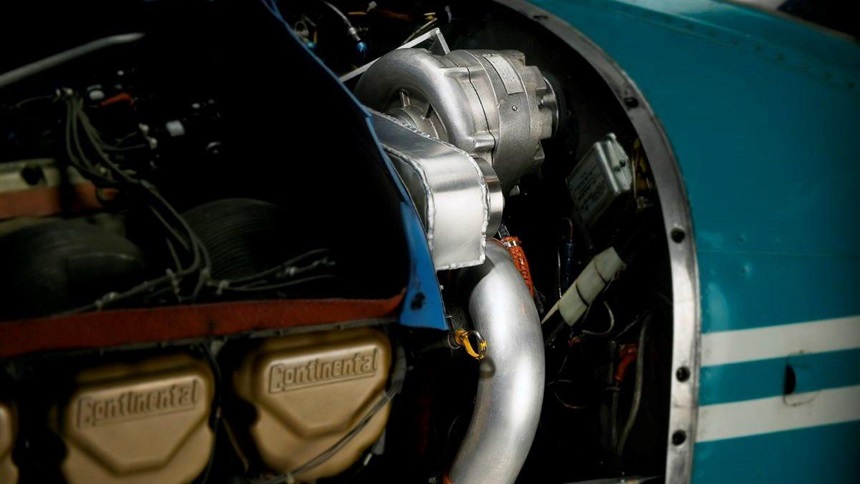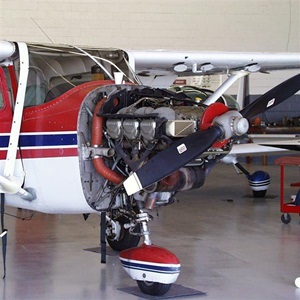Maintaining Your Engine
Safety Spotlight: Aircraft Systems

You can get maximum life out of your engine if you treat it well before, during and after flight—and if you keep up with recommended maintenance procedures.
How to Make Your Engine Live Longer
- First and foremost—try to fly your engine at least an hour a week. Far more engines rust out than wear out. They rust because the oil drains off the cylinder walls and the moisture in the air then reacts with the iron in the engine. The rust creates roughness, which increases wear.
- Piston aircraft engines are made mostly of steel and aluminum, which expand and contract at different rates, depending on temperature. When flying at varying altitudes and from one climatic zone to another, temperature changes can be extreme. If you keep large engine temperature changes over a short period of time to a minimum, and within prescribed limits, the safety, reliability and longevity of the engine are significantly enhanced. For example, avoiding rapid descents at idle power near your destination airport will help avoid “shock cooling,” which is the too-rapid cooling of hot engine metals. Shock cooling causes stress that can lead to cylinder head cracks. To avoid this, begin descent planning farther out and descend at a slower rate with a low cruise power setting.
- Airflow and fuel-air mixture affect engine temperature, as well. Your job is to keep engine temperatures at settings that maximize engine life. For example, an engine with a redline oil temperature of 250 degrees F will last much longer running at 180 degrees than 240 degrees. Keeping an engine too cool in flight can also be harmful; if oil cannot get hot enough to burn off water that has condensed in it, internal engine rust can occur. Engine experts suggest an oil temperature of around 180 degrees or a little higher as a happy medium for typical air-cooled GA engines. Oil’s primary function is to lubricate engine parts, but with the help of air flowing through the cowling and the oil cooler it also transfers heat out of the engine.
Using Gauges for More Precise Temperature Control
 All airplanes have an oil temperature gauge, but, depending on the aircraft, two other sources of engine temperature information may be available:
All airplanes have an oil temperature gauge, but, depending on the aircraft, two other sources of engine temperature information may be available:
CHT—A cylinder head temperature (CHT) gauge measures just that, the temperature at the cylinder head. CHT is a critical indicator of engine health, especially on high-powered turbocharged engines.
CHT can be adjusted with cowl flaps, if equipped, and by adjusting fuel and airflow. On hot days, you may need to enrich the mixture, open cowl flaps, lower the nose, or even reduce power to keep CHTs within limits. Always consult the POH to learn how to manage high engine temperatures.
EGT—An exhaust gas temperature (EGT) gauge measures the temperature as the exhaust leaves the cylinder. If the engine is turbocharged, the gases will be measured just before entering the turbocharger, by a turbine inlet temperature (TIT) gauge.
Lean the mixture by pulling the mixture control aft, which reduces the amount of fuel mixing with the air entering the engine. The fuel-air mixture thus becomes “leaner” because less fuel mixes with the same amount of air. When leaning the mixture, the EGT gauge shows the temperature climbing until the cylinder being measured reaches its peak temperature (peak EGT), indicating relatively efficient fuel-air combustion. Refer to the POH for correct mixture settings at various power settings.
When the mixture control is moved forward from peak EGT, the mixture is said to be rich of peak (ROP) because more fuel is being added to the fuel-air mixture. Moving the mixture control aft from the peak EGT position removes fuel from the mixture and thus the mixture is lean of peak (LOP). In both cases, actual EGT is lower than peak EGT.
For most airplanes, correct mixture settings are detailed in the POH. As you gain experience with leaning, you’ll find that it saves gallons of fuel and helps the engine run better. Follow the POH mixture settings carefully; this is not the time to experiment on your expensive engine.
Tip: Pilots should lean appropriately anytime they are below 75 percent power, regardless of altitude.
Inspections and Major Surgery (Overhauls)
An annual or 100-hour inspection is done to the entire aircraft. The inspection must be signed off in the “aircraft” logbook, which means that the inspection applies to everything on the aircraft. However, it is often helpful to have the inspection signed off by the mechanic in the “engine” logbook as well, so that inspection status is easy to determine. No matter which logbook is used, there are specific requirements for the inspection of the engine. These requirements can be found in the federal aviation regulations (FARs) and in the manufacturer’s maintenance manuals.
Typical items that a mechanic examines include:
- Engine compression: leakage inside the cylinders
- Oil system: leakage and metal in oil filter
- Fuel system: filters and leaks
- Exhaust system: leaks could allow carbon monoxide into the cabin or cause fires
Time between overhaul (TBO) is a recommendation by the engine manufacturers to indicate the expected engine overhaul interval. TBO is given in both hours on the engine and calendar time. Many Lycoming engines, for example, have an hourly TBO of 2,000 hours and a calendar TBO of 12 years. If an engine has only 300 hours but 20 years have passed since its last overhaul, it is likely in need of an overhaul.
These intervals are based on extensive engine testing and years of field experience. Remember that your airplane engine operates at much higher power settings for much longer than a typical car engine. Regular service and overhauls are essential to ensure that your engine delivers reliable, safe power every time you fly.
 When you and your mechanic decide that it’s time for major engine service, there are three possibilities:
When you and your mechanic decide that it’s time for major engine service, there are three possibilities:
- Top Overhaul. Top overhaul refers to repair or replacement of an engine’s “top end,” the cylinders. The term “top overhaul” is not formally defined, however, and you may see it used to cover everything from minor cylinder repairs to complete replacement of all cylinders.
Typically, though, a top overhaul includes the removal of one or more of the engine’s cylinders, and a rebuild of cylinders with existing or replacement parts. It also can include the reconditioning of the cylinder walls, inspection of the pistons, valve operating mechanism, valve guides and seats, and replacing piston and piston rings.Regular service and overhauls are essential to ensure that your engine delivers reliable, safe power every time you fly.
Airplanes that seldom fly can develop engine problems due to corrosion, and these are frequently good candidates for some cylinder work between TBO intervals. A top overhauled engine carries forward all previous time in the engine logbook—a factory rebuilt or factory remanufactured engine goes back to zero time.
- Engine Overhaul. An overhaul involves complete disassembly, cleaning, and renewal or replacement of all engine parts and components. Overhauls reset the TBO clock back to zero, although the engine continues to carry its previous total time.
Overhaul quality varies, depending on the standards of the mechanic or shop performing the overhaul. The minimum requirements for an overhaul are to ensure that parts meet overhaul limits (dimensions), which are not as stringent as new part limits. Differences in overhaul pricing usually reflect the limits used during the overhaul. - Remanufacture. Engine manufacturers are authorized by the FAA to overhaul an engine using new parts and to designate that engine as "factory remanufactured."
P–51 Engine Out, Off-Airport Landing—Full Analysis
British warbird pilot, Mark Levy, was part of a 21-airplane formation in the annual airshow at Duxford, England, when the P-51 he was flying had a partial engine out. Levy recorded the entire event on a pair of point-of-view video cameras, and he shared the images, as well as his lessons learned, in a candid discussion with AOPA Air Safety Institute Executive Director Richard McSpadden.